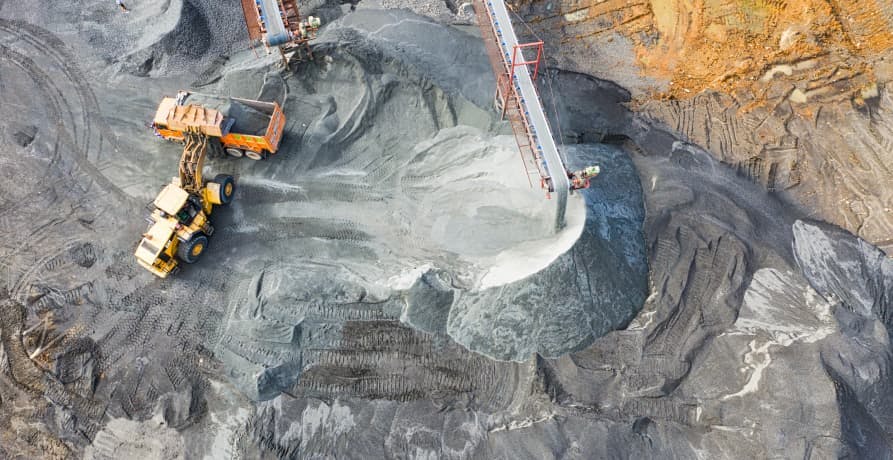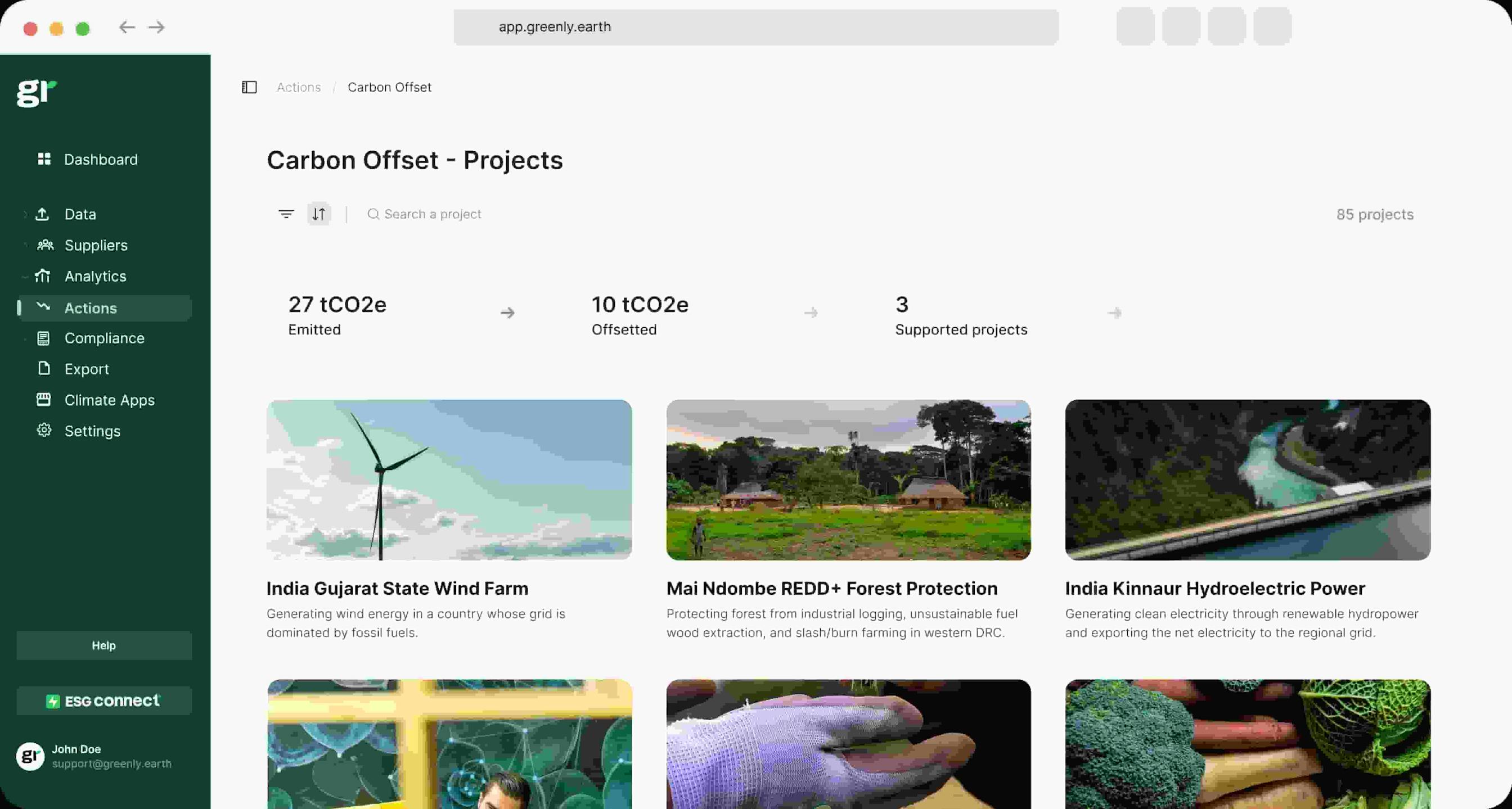Downstream vs upstream emissions - what do these terms mean and why are they important in the context of carbon accounting?
ESG / CSR
2023-09-21T00:00:00.000Z
2024-07-16T00:00:00.000Z
en-gb
As businesses turn their attention to sustainability and the transition to net zero, understanding the complexities of the emissions landscape has never been more important. This article focuses on a particular aspect of this - upstream and downstream emissions; key components that often comprise the bulk of a company's carbon footprint.
Understanding these emission sources is critical for effective carbon management. Whether you're a business leader, sustainability manager, or simply someone keen on understanding the mechanisms of climate change, this article will take you through the ins and outs of upstream and downstream emissions and why it's important to know what they are.
👉 Downstream vs upstream emissions: what do these terms mean and why are they important in carbon accounting?
What Are Carbon Emissions?
Before we dive into downstream vs upstream emissions, let's quickly go over some of the basics - i.e. what are carbon emissions?
Carbon emissions refer to the release of carbon dioxide into the atmosphere. These emissions primarily result from the burning of fossil fuels like coal, oil, and natural gas for energy. Other sources include human activities such as deforestation, industrial processes, and agricultural practices.
Carbon emissions are a key contributor to climate change - something that's changing weather patterns across the globe and increasing the frequency and intensity of extreme weather events such as heatwaves, flooding, and storms.
Understanding and tracking carbon emissions is crucial for both individuals and businesses for several reasons. First, carbon emissions have a direct impact on the health of our planet, affecting ecosystems, biodiversity, and even human health. Monitoring these emissions helps to identify the primary sources and therefore create effective strategies for reduction.
Second, for companies, carbon tracking is not just an environmental responsibility but is increasingly becoming a financial and reputational necessity. Governments and consumers are growing more conscious of climate change, leading to the development of regulations and a preference for businesses that have lower carbon footprints. This is why understanding both downstream and upstream aspects of carbon emissions is essential for effective carbon management.

What Is Carbon Accounting?
The second concept that's crucial to understanding upstream and downstream emissions is carbon accounting.
Carbon accounting involves the quantification of carbon dioxide, methane, and other greenhouse gases emitted during various activities or operations. The collected data is then analysed to formulate strategies aimed at reducing an organisation's carbon footprint. The methodology extends from individual projects to entire organisational operations, giving a company a holistic view of its emissions.
“The importance of carbon accounting can't be overstated in today's world, where climate change is a growing threat. For businesses in particular, proper emission management is not just an ethical obligation but increasingly a legal requirement, as governments around the world tighten environmental regulations. ”
But carbon accounting shouldn't be viewed as an imposition, as managing emissions brings with it a whole host of advantages. Companies that actively engage in carbon accounting are likely to find themselves better positioned for success, as consumers are increasingly leaning towards eco-friendly brands. Additionally, comprehensive carbon accounting can also help companies identify inefficiencies in their operations, offering the potential for cost savings.
💡 A survey conducted by BCG found that 40% of respondents who actively reduce emissions report annual financial benefits of at least $100 million. This is achieved through collaboration with suppliers and customers, accurate product-level measurement, and the implementation of automated digital solutions.
Upstream vs Downstream Emissions - Why Are They Important?
The Greenhouse Gas Protocol - the most commonly used framework for calculating a company's greenhouse gas emissions - categorises Scope 3 emissions into either upstream or downstream sources. For the majority of businesses, Scope 3 typically constitutes the largest portion of their carbon footprint.
👉 Also referred to as value chain emissions, Scope 3 is responsible for approximately 90% of an average company's impact on the climate.
For a thorough understanding and reduction of your business's carbon emissions, it's essential to fully grasp your Scope 3 emissions. This involves calculating both upstream and downstream sources of emissions linked to the production process of a product or service. Understanding upstream and downstream services and operations is crucial for identifying all emission points within your value chain.
A quick refresh on scope 1, 2, and 3 emissions:
| Scope |
Description |
| Scope 1 |
This is direct greenhouse gas emissions stemming from resources that are owned and controlled by an organisation. For example, emissions produced by company facilities or a company-owned vehicle. |
| Scope 2 |
This is indirect energy emissions resulting from a company's consumption of electricity, heat, or steam in company facilities or vehicles. |
| Scope 3 |
This is all other indirect emissions occurring either upstream or downstream in the company's value chain. Scope 3 emissions usually account for the majority of a company's emissions, which is why it's so important for companies to measure these emissions. It's also why the category is further broken down into upstream and downstream sources. |
What Are Upstream Emissions?
Upstream emissions refer to greenhouse gas emissions stemming from the production of goods or services that a company purchases or uses.
The Greenhouse Gas Protocol outlines eight upstream emissions categories. These are:
- Purchased Goods and Services: This includes emissions arising from the extraction of raw materials, manufacturing, and transportation of any items or services purchased by the company. An example of an upstream service could include the extraction and refining of crude oil before it is transported to manufacturers.
- Capital Goods: Emissions arising from the extraction, manufacturing process, and transportation of capital goods acquired by the company.
- Fuel and Energy Use: Emissions arising from the extraction, manufacturing, and transportation of fuels (such as oil and gas) and energy that are not already included under Scope 2 or 3 emissions.
- Upstream Transport and Distribution: This covers emissions linked to the transportation and distribution of the company's purchased products. This category also includes logistics and transportation such as supply chain services, outbound logistics, and transportation between company facilities.
- Operational Waste: Emissions produced as a result of the disposal or treatment of operational waste. This excludes emissions linked to in-house waste management facilities.
- Business Travel: Emissions resulting from employee transportation for business-related activities in vehicles not belonging to the company.
- Employee Commuting: This covers emissions resulting from an employee's commute between their home and office where the vehicles used don't belong to the company.
- Upstream Leased Assets - This includes any assets leased by the company that fall out with Scope 1 and 2 emissions.
Real-world examples of upstream emissions are incredibly varied and depend on the specific operations and industry of the company. In the automotive industry, for example, it might include emissions resulting from the extraction of metals for car parts and the production of synthetic materials for interiors, involving both upstream operations and upstream services.
In the case of a food retailer, emissions linked to a company's upstream supply chain could include those resulting from the manufacturing of plastic containers used to sell their produce. It even encompasses emissions related to the extraction and processing of coal, crude oil, or natural gas, which are not already accounted for in Scope 1 or 2 emissions.

Why Is It Important to Calculate Upstream Emissions?
Although upstream emissions are not directly controlled by the company, they arise from activities within the supply chain, such as suppliers' manufacturing processes, raw material extraction, and contracted transportation services. These emissions, while essential to the company's operations, are produced by sources that the company does not own or operate.
A company can influence these emissions through its procurement choices, supplier engagement, and by setting sustainability incentives for its supply chain partners. Through strategic decision-making and collaboration with suppliers, companies can encourage more sustainable practices in upstream services, thereby reducing the overall Scope 3 emissions associated with their products or services.
“Calculating upstream emissions is crucial for a comprehensive understanding of a company's total carbon footprint, encompassing emissions from the entire value chain beyond direct operations. This detailed accounting aids supply chain accountability, offers competitive advantages, and prepares companies for regulatory compliance. ”
What Are Downstream Emissions?
Downstream emissions are the greenhouse gases emitted during the use, end-of-life treatment, and disposal phases of a product or service. Essentially, these emissions occur after the product has been sold to the end consumer and encompass various downstream services and downstream processes.
The Greenhouse Gas Protocol breaks down downstream emissions into seven distinct categories:
- Downstream Transportation and Distribution: This includes emissions linked to the delivery and distribution of company products, including covering downstream services such as logistics and transportation. An example of a downstream service could include the distribution and delivery of finished products to retail stores or directly to consumers.
- Processing of Sold Products: Emissions related to the processing of products sold by third parties (part of the downstream process that prepares the products for final use).
- Use of Sold Products: Emissions stemming from the final use of the goods and services.
- End-of-Life Disposal and Treatment: Any emissions related to waste disposal or treatment of the company's products.
- Downstream Leased Assets: Emissions stemming from a company's leased assets to organisations or individuals.
- Franchises: Any emissions created by the operation of franchises that do not fall under Scope 1 or 2 emissions.
- Investments: Emissions linked to the operation of investments, including the financing of projects.
Like upstream emissions, those produced from a company's downstream supply chain vary significantly across different industries. For a vehicle manufacturer, downstream emissions include those produced when consumers drive their cars. In the case of a company selling electronic gadgets, these emissions result from electricity consumption during the gadgets' use. For consumer goods like packaged food or drinks, downstream emissions can involve the energy required for refrigeration and the emissions from waste disposal, such as landfill decomposition or incineration, highlighting the downstream dependency on effective waste management services.

Why Is It Important to Calculate Downstream Emissions?
Tracking downstream emissions is critical for a number of reasons. First, they often constitute a significant portion of a product's overall carbon footprint. Ignoring them means missing a large part of the emissions puzzle.
Second, understanding downstream emissions can help businesses make more eco-friendly products and can influence consumer education. For example, if a company knows that most emissions from its product occur during the usage phase, it can develop lower-energy-consuming alternatives or educate consumers on efficient usage.
However, monitoring downstream emissions presents a unique set of challenges. For one, these emissions are typically outside the direct control of the company that produced the product, making it difficult to collect precise data. Consumer usage patterns can also be highly variable, and waste disposal practices differ widely across regions. Despite these difficulties, effective tracking of downstream emissions is increasingly important for full-spectrum carbon accounting, regulatory compliance, and fostering a sustainable brand image.
Understanding and managing these emissions is crucial as downstream services depend on efficient processes and proper end-of-life care to mitigate the environmental impact, emphasising the importance of reducing downstream dependency on high-emission activities.
A Summary of Upstream vs Downstream
Distinguishing between upstream and downstream sources might sound complex, but it actually boils down to one simple question - who paid for the goods or services? If it's the company then it's upstream, if it's the consumer then it's downstream.
Let's take a closer look at some of the other key differences between upstream and downstream scope 3 emissions:
- Phase of Life Cycle: Scope 3 upstream emissions are indirect greenhouse gas emissions that occur outside of a company's direct operations but are associated with activities in its supply chain, such as raw material extraction, manufacturing, and transportation. Downstream emissions, on the other hand, occur post-sale during the use, end-of-life treatment, and disposal stages.
- Control - Although upstream emissions are not directly within the control of the company, through partnerships with suppliers they may be able to indirectly influence these emissions. Downstream emissions on the other hand often depend on consumer behaviour and waste management practices, making them harder to control.
- Data Collection: Tracking upstream emissions involves data collected from suppliers and can be relatively straightforward if the supply chain is well-managed. Conversely, downstream emissions tracking can be challenging due to the variability in consumer usage and waste disposal practices.
- Regulatory Implications: Regulations for Scope 3 emissions, both upstream and downstream, are generally less stringent than for Scope 1 and Scope 2 emissions, focusing more on disclosure than mandatory reductions (though this is changing as regulations become more rigorous). Upstream and downstream Scope 3 emissions may also be indirectly influenced by various laws, such as supplier standards or end-of-life disposal rules, which vary by jurisdiction and evolve over time.
- Dependency: There is no upstream dependency on downstream services and operations, as upstream processes do not need to consider downstream activities. However, downstream services care about upstream processes because they rely on the initial stages of production and supply to function effectively.
The Importance of Calculating Scope 3 Upstream and Downstream Emissions
Understanding and accounting for emissions related to upstream and downstream operations are fundamental steps in addressing an organisation's total carbon footprint, across its entire supply chain. From raw material extraction to consumer usage and waste disposal, each stage of a product's life cycle contributes to its overall environmental impact. Ignoring Scope 3 emissions results in an incomplete and potentially misleading picture, it also reduces the effectiveness of carbon reduction strategies.
👉 Understanding upstream and downstream emissions enables companies to identify emission hotspots, develop targeted reduction strategies, and meet regulatory requirements. As the global focus on sustainability intensifies, adopting robust accounting methods becomes not just good practice, but a business imperative.
The benefits of calculating Scope 3 emissions:
Comprehensive Carbon Footprint:
- Understanding the Full Impact: Scope 3 emissions often make up the majority of a company's total greenhouse gas (GHG) emissions. They encompass all indirect emissions that occur in the value chain, which are not covered by Scope 1 (direct emissions from owned or controlled sources) and Scope 2 (indirect emissions from the generation of purchased electricity). For many companies, Scope 3 emissions can represent up to 90% of their total emissions.
- Informed Decision Making: By calculating these emissions, companies gain a complete picture of their environmental impact, enabling them to make informed decisions about where to focus their reduction efforts.
Regulatory Compliance and Risk Management:
- Meeting Legal Requirements: Increasingly, governments and regulatory bodies are mandating comprehensive GHG reporting, which includes Scope 3 emissions. Compliance with these regulations is essential to avoid legal penalties and maintain business licenses.
- Identifying Risks: Calculating Scope 3 emissions helps identify risks in the supply chain, such as regulatory risks, reputational risks, and physical risks from climate change. This can help companies mitigate potential disruptions and maintain business continuity.
Enhancing Corporate Reputation and Stakeholder Trust:
- Transparency and Accountability: Transparent reporting on all emission scopes enhances a company's reputation and builds trust with stakeholders, including customers, investors, and regulatory bodies. Companies that demonstrate a commitment to sustainability are more likely to attract environmentally conscious consumers and investors.
- Competitive Advantage: Companies that lead in sustainability reporting often gain a competitive edge in the market. They can differentiate themselves by showcasing their efforts to reduce their environmental footprint, thereby appealing to a growing segment of eco-conscious consumers and partners.
Driving Innovation and Efficiency:
- Operational Improvements: By identifying and measuring Scope 3 emissions, companies can uncover inefficiencies in their operations and supply chain. This can lead to innovations in processes, product design, and sourcing strategies that reduce emissions and cut costs.
- Supply Chain Collaboration: Engaging with suppliers to reduce upstream emissions can foster closer relationships and drive joint sustainability initiatives. This collaboration can lead to improved practices and innovations across the supply chain, benefiting all parties involved.
Achieving Sustainability Goals:
- Setting and Meeting Targets: Accurate measurement of Scope 3 emissions is essential for setting realistic and achievable sustainability targets. It allows companies to track progress and make data-driven adjustments to their strategies, ensuring they meet their long-term environmental goals.
- Contribution to Global Goals: Reducing Scope 3 emissions is vital for contributing to global climate targets, such as those set by the Paris Agreement. Companies play a critical role in the collective effort to limit global warming to well below 2°C, and calculating these emissions is the first step in making meaningful contributions.
Tips for Calculating Upstream and Downstream Emission
Calculating upstream and downstream emissions can be a complex task, but following these tips can help streamline the process and ensure accuracy:
Map Your Value Chain:
- Identify Key Activities: Start by mapping out all the activities in your value chain, from raw material extraction to the disposal of finished products. This will help you identify all potential sources of emissions.
- Understand materials flow and dependencies: Understanding the processes involved in both upstream and downstream services and operations is crucial for identifying all emission points within your value chain. Recognising the dependency chain and the interconnections between the companies involved in your supply chain can help in developing strategies to mitigate emissions.
- Engage Stakeholders: Collaborate with suppliers, customers, and other stakeholders to gain insights into the emissions associated with each stage of the value chain.
Collect Accurate Data:
- Use Primary Data: Wherever possible, use primary data collected directly from your operations and those of your suppliers. This could include fuel consumption, energy use, and waste generation data.
- Leverage Secondary Data: When primary data is not available, use reputable secondary data sources such as industry averages or databases like the GHG Protocol database.
Categorise Emissions:
- Scope 3 Categories: Follow the GHG Protocol’s Scope 3 standard, which categorises emissions into 15 distinct categories. Ensure you understand which categories apply to your business.
- Upstream vs Downstream: Clearly differentiate between upstream emissions (e.g., purchased goods and services, transportation) and downstream emissions (e.g., use of sold products, waste treatment).
Implement Digital Solutions:
- Use Software Tools: Employ carbon accounting software to track and calculate emissions. These tools can automate data collection and improve accuracy.
- Integrate Systems: Ensure your emissions tracking systems are integrated with other business systems, such as supply chain management and ERP systems, for seamless data flow.
Set Clear Boundaries:
- Organisational Boundaries: Define the boundaries of your calculations, including which entities and activities are included.
- Operational Boundaries: Clarify which emission sources are considered within your operational control and which are part of your value chain.
Use Standardised Conversion Factors:
- Consistency: Use standardised emission factors for converting activity data (e.g., fuel use, electricity consumption) into CO2 equivalents. The GHG Protocol and other environmental agencies provide these factors.
- Regular Updates: Ensure you use the most recent conversion factors, as they are periodically updated to reflect new scientific data.
Validate and Verify Data:
- Internal Audits: Regularly audit your emissions data to ensure accuracy and completeness. This helps identify any gaps or errors in data collection.
- Third-Party Verification: Consider third-party verification to enhance the credibility of your emissions reporting. Verified data is more reliable and can be used confidently for reporting and decision-making.
Report Transparently:
- Detailed Reporting: Provide detailed reports on your Scope 3 emissions, including methodologies used, data sources, and assumptions made.
- Stakeholder Communication: Communicate your emissions data and reduction efforts transparently to stakeholders, including investors, customers, and regulatory bodies.
Continuous Improvement:
- Monitor Progress: Continuously monitor your emissions and the effectiveness of your reduction initiatives. Use this data to refine your strategies and set more ambitious targets.
- Stay Informed: Keep up to date with the latest developments in emissions calculation methodologies, regulatory requirements, and best practices in sustainability.
👉 By following these tips, companies can effectively calculate their upstream and downstream emissions, gaining a comprehensive understanding of their carbon footprint and identifying opportunities for improvement.

Main Challenges Companies Face When Calculating Upstream and Downstream Emissions
Calculating Scope 3 upstream and downstream emissions can admittedly be complicated and time-consuming. However, various tools and specialist companies are available to assist businesses in calculating these emissions. However, companies such as Greenly can help to make the whole process as straightforward and pain-free as possible, so why not get in touch today?
Data Availability and Quality:
- Control Issues: Companies often lack direct control over their upstream and downstream activities, making data collection difficult. Suppliers and customers may not have or share necessary data.
- Inconsistencies: Data from different sources can vary in format and accuracy, complicating aggregation and analysis.
Complex Supply Chains:
- Multiple Tiers: Complex, multi-tiered supply chains make it hard to track emissions across all levels.
- Geographic Dispersion: Suppliers and customers may be spread across various regions, each with different regulations and data availability.
Resource Intensive:
- High Costs: Collecting and verifying emissions data requires significant financial and human resources, which can be particularly challenging for smaller companies.
- Time-Consuming: The process of data collection, standardisation, and verification is time-consuming, potentially delaying sustainability initiatives.
Lack of Standardisation:
- Varied Methodologies: Different approaches to calculating Scope 3 emissions lead to inconsistencies in reporting.
- Evolving Standards: Constantly changing standards and regulations require regular updates to methodologies, which can be resource-intensive.
Supplier and Customer Engagement:
- Limited Influence: Companies often have limited influence over suppliers and customers, making data collection and implementation of reduction strategies challenging.
- Incentivising Participation: It can be difficult to encourage suppliers and customers to share data or participate in emissions reduction without providing clear incentives.
Technical and Analytical Challenges:
- Complex Calculations: Accurate emissions calculations require sophisticated technical and analytical skills.
- Data Integration: Integrating emissions data with existing business systems can be technically challenging.
How Greenly Can Help
Greenly can alleviate some of these challenges by providing comprehensive tools and expert support to streamline and enhance the process of calculating and managing Scope 3 emissions. Here's how Greenly can help:
Carbon Calculation and Management
- Carbon Measurement: Greenly's advanced technology enables accurate calculation of Scope 1, 2, and 3 emissions. The platform integrates financial and physical data, ensuring thorough emission assessments.
- Expert Support: Greenly's team of climate experts assists in building custom action plans to reduce emissions, offering continuous support to achieve significant reductions.
- Intuitive Platform: The seamless platform facilitates the importing of data, integration with industry-specific software, and monitoring of emissions, allowing for efficient tracking of progress and informed decision-making.
Life Cycle Assessment (LCA)
- Full Impact Analysis: Greenly’s LCA service offers detailed insights into the environmental impact of products throughout their life cycle, from raw material extraction to disposal.
- Competitive Edge: Performing an LCA enhances transparency with customers and provides a competitive advantage by demonstrating a commitment to sustainability.
- Customiseable and Compliant: The LCA can be tailored to fit specific needs and complies with key industry standards like ISO 14040 and 14044, ensuring reliable and actionable results.
Supplier Procurement
- Supply Chain Decarbonisation: Greenly helps companies engage with suppliers to measure and reduce Scope 3 emissions, fostering collaboration and transparency across the value chain.
- Sustainable Sourcing: Greenly’s platform allows companies to identify and partner with low-carbon suppliers, enhancing the sustainability of procurement practices.
- Certification and Reporting: Companies can showcase their commitment to sustainability through certified results and improved transparency in their RSE communication.
By leveraging Greenly's services, companies can overcome the challenges of calculating and managing upstream and downstream emissions, driving meaningful progress toward sustainability and compliance with evolving regulations. Get in touch with us today to start your sustainability journey.









